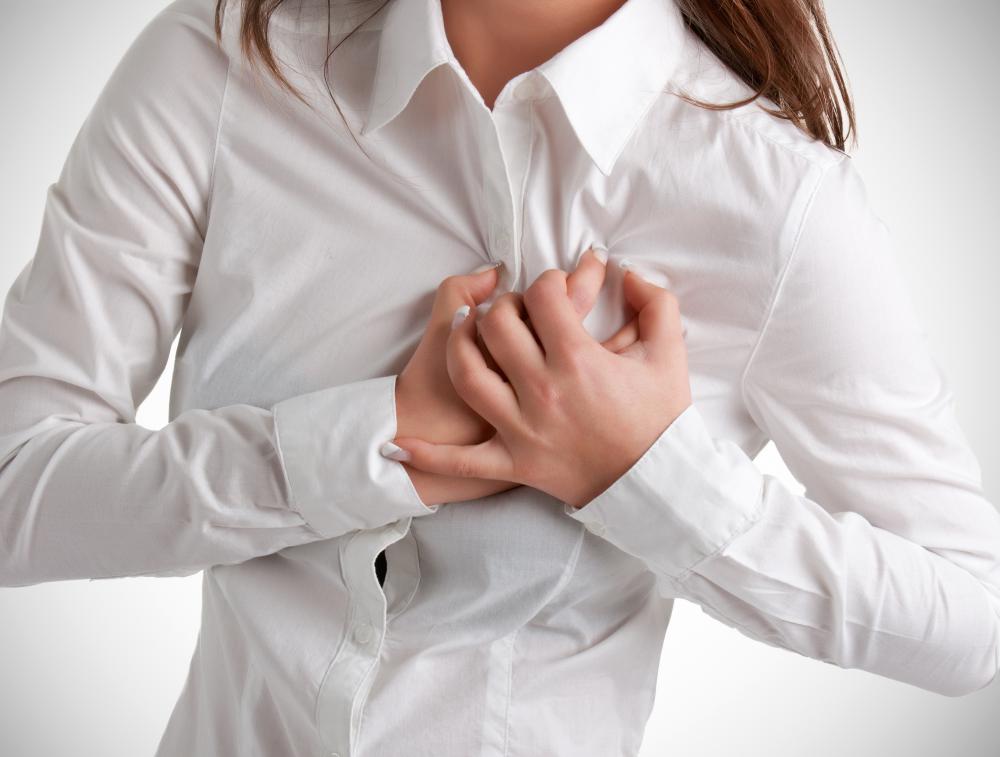At TheHealthBoard, we're committed to delivering accurate, trustworthy information. Our expert-authored content is rigorously fact-checked and sourced from credible authorities. Discover how we uphold the highest standards in providing you with reliable knowledge.
What are the Different Chest Strain Symptoms?
There are several different chest strain symptoms. Different symptoms occur based on the severity of the strain. There are mild strains, which cause little discomfort. Moderate strains can cause more pain, as well as swelling and bruising. Worse pain, swelling, and weakness may be caused by a severe muscle strain.
The major muscles of the chest are called pectoral muscles. When these muscles are stretched too far, typically during exercise, the muscle tissue can tear. This is called a pulled or strained muscle. Chest strains often occur while there is a lot of adrenaline pumping through the system. The adrenaline may delay the onset of chest strain symptoms.

The symptoms of chest strain vary depending on the severity of the injury. The most common symptom of a pulled chest muscle is pain while stretching or moving the arms. This is because the pectoral muscles are connected to arm movement. In fact, these are some of the primary muscles worked when doing push-ups. Pushing motions of the arms may lead to pain when a chest muscle tear is present.

Other symptoms include muscle spasms, swelling, and bruising. The swelling and bruising occur with the injury. It is unclear what actually causes muscle spasms, but they are associated with muscle strains. A muscle spasm is experienced as an involuntary muscle contraction. These can be especially painful, especially when there is already damage to the muscle or tendon fibers.

Loss of strength is another example of chest strain symptoms. Loss of muscle strength typically occurs in moderate to severe strains. Another symptom of the severe side of chest muscle injuries is a crackling sensation when the muscle is pressed with the fingers. Calcification of the chest muscle is also among the chest strain signs, but this can only be seen with an X-ray.

Mild symptoms of chest strain are classified as a grade 1 strain. A mild strain indicates that the muscle is pulled and no tearing has occurred. These strains cause discomfort, but the injury is not bad enough to interfere with daily activities. There is typically no bruising or swelling caused by this degree of chest muscle injury. Muscle strength remains unaffected.

Moderate chest strain symptoms are classified as a grade 2 strain. This means that there has been some damage to the muscle tissue or tendons. This type of strain causes more discomfort than a grade 1 strain and may limit some physical activities. Grade 2 strains may also involve some bruising and swelling. Some muscle weakness may also be experienced.

Grade 3 strains are reserved for severe chest strain symptoms. Severe chest strains typically indicate that a rupture of the muscle attachment to the ribs has occurred. These strains are associated with severe pain, bruising, and swelling in the chest. Muscle strength is significantly diminished.
Chest muscle strains can be caused by any activity that exerts the pectoral muscles. Chronic chest strains are caused by overuse of the muscle. Alternately, an acute chest strain is caused by a singe, blunt injury to the chest muscles. Strains and pulls can be prevented by properly warming up the muscles before strenuous activity. Slowly building up muscle strength can also help to prevent injury.
AS FEATURED ON:
AS FEATURED ON:

















Discussion Comments
This happened to me when I worked a summer at McDonald's. I was walking to the front register, past the french fry bin, and slipped on a greasy spot on the floor. I put out a hand to catch myself, and slammed into the side of the fry bin, smacking my ribs.
My arm was in the bin (mostly empty, fortunately), but it was hot, and I tried to extricate myself and somehow wrenched my arm and chest muscle on the right side, before I finally collapsed against the fry bin. I couldn't get any traction on the greasy floor.
I went to the ER for a chest X-ray, but no rbs were broken. The doc said I might have bruised a rib, and had certainly strained a chest muscle. It hurt like stink for a few days, but I survived. Not interested in a repeat incident, though.
Post your comments